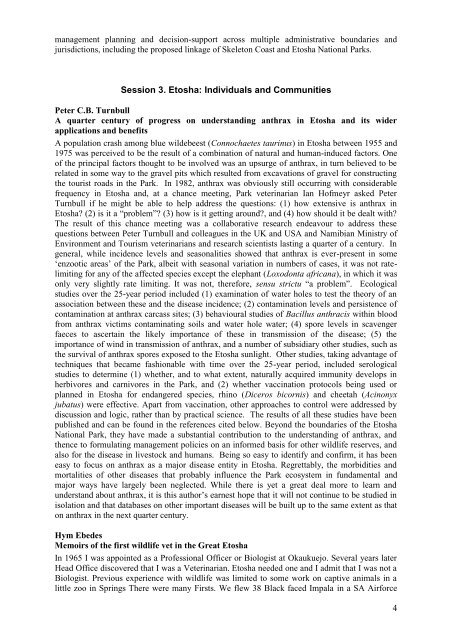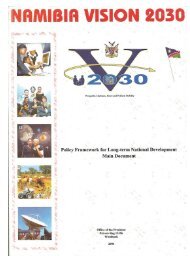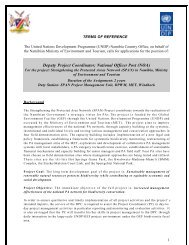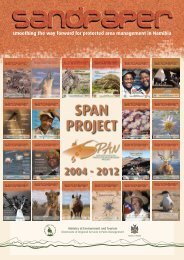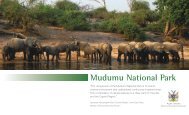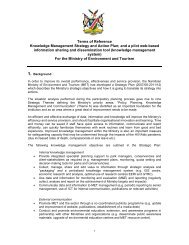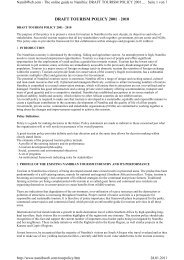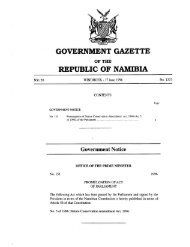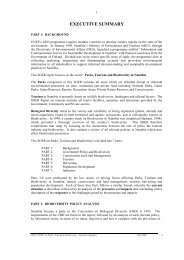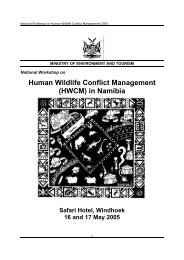Etosha: the Human Footprint - Ministry of Environment and Tourism
Etosha: the Human Footprint - Ministry of Environment and Tourism
Etosha: the Human Footprint - Ministry of Environment and Tourism
You also want an ePaper? Increase the reach of your titles
YUMPU automatically turns print PDFs into web optimized ePapers that Google loves.
management planning <strong>and</strong> decision-support across multiple administrative boundaries <strong>and</strong><br />
jurisdictions, including <strong>the</strong> proposed linkage <strong>of</strong> Skeleton Coast <strong>and</strong> <strong>Etosha</strong> National Parks.<br />
Session 3. <strong>Etosha</strong>: Individuals <strong>and</strong> Communities<br />
Peter C.B. Turnbull<br />
A quarter century <strong>of</strong> progress on underst<strong>and</strong>ing anthrax in <strong>Etosha</strong> <strong>and</strong> its wider<br />
applications <strong>and</strong> benefits<br />
A population crash among blue wildebeest (Connochaetes taurinus) in <strong>Etosha</strong> between 1955 <strong>and</strong><br />
1975 was perceived to be <strong>the</strong> result <strong>of</strong> a combination <strong>of</strong> natural <strong>and</strong> human-induced factors. One<br />
<strong>of</strong> <strong>the</strong> principal factors thought to be involved was an upsurge <strong>of</strong> anthrax, in turn believed to be<br />
related in some way to <strong>the</strong> gravel pits which resulted from excavations <strong>of</strong> gravel for constructing<br />
<strong>the</strong> tourist roads in <strong>the</strong> Park. In 1982, anthrax was obviously still occurring with considerable<br />
frequency in <strong>Etosha</strong> <strong>and</strong>, at a chance meeting, Park veterinarian Ian H<strong>of</strong>meyr asked Peter<br />
Turnbull if he might be able to help address <strong>the</strong> questions: (1) how extensive is anthrax in<br />
<strong>Etosha</strong> (2) is it a “problem” (3) how is it getting around, <strong>and</strong> (4) how should it be dealt with<br />
The result <strong>of</strong> this chance meeting was a collaborative research endeavour to address <strong>the</strong>se<br />
questions between Peter Turnbull <strong>and</strong> colleagues in <strong>the</strong> UK <strong>and</strong> USA <strong>and</strong> Namibian <strong>Ministry</strong> <strong>of</strong><br />
<strong>Environment</strong> <strong>and</strong> <strong>Tourism</strong> veterinarians <strong>and</strong> research scientists lasting a quarter <strong>of</strong> a century. In<br />
general, while incidence levels <strong>and</strong> seasonalities showed that anthrax is ever-present in some<br />
„enzootic areas‟ <strong>of</strong> <strong>the</strong> Park, albeit with seasonal variation in numbers <strong>of</strong> cases, it was not ratelimiting<br />
for any <strong>of</strong> <strong>the</strong> affected species except <strong>the</strong> elephant (Loxodonta africana), in which it was<br />
only very slightly rate limiting. It was not, <strong>the</strong>refore, sensu strictu “a problem”. Ecological<br />
studies over <strong>the</strong> 25-year period included (1) examination <strong>of</strong> water holes to test <strong>the</strong> <strong>the</strong>ory <strong>of</strong> an<br />
association between <strong>the</strong>se <strong>and</strong> <strong>the</strong> disease incidence; (2) contamination levels <strong>and</strong> persistence <strong>of</strong><br />
contamination at anthrax carcass sites; (3) behavioural studies <strong>of</strong> Bacillus anthracis within blood<br />
from anthrax victims contaminating soils <strong>and</strong> water hole water; (4) spore levels in scavenger<br />
faeces to ascertain <strong>the</strong> likely importance <strong>of</strong> <strong>the</strong>se in transmission <strong>of</strong> <strong>the</strong> disease; (5) <strong>the</strong><br />
importance <strong>of</strong> wind in transmission <strong>of</strong> anthrax, <strong>and</strong> a number <strong>of</strong> subsidiary o<strong>the</strong>r studies, such as<br />
<strong>the</strong> survival <strong>of</strong> anthrax spores exposed to <strong>the</strong> <strong>Etosha</strong> sunlight. O<strong>the</strong>r studies, taking advantage <strong>of</strong><br />
techniques that became fashionable with time over <strong>the</strong> 25-year period, included serological<br />
studies to determine (1) whe<strong>the</strong>r, <strong>and</strong> to what extent, naturally acquired immunity develops in<br />
herbivores <strong>and</strong> carnivores in <strong>the</strong> Park, <strong>and</strong> (2) whe<strong>the</strong>r vaccination protocols being used or<br />
planned in <strong>Etosha</strong> for endangered species, rhino (Diceros bicornis) <strong>and</strong> cheetah (Acinonyx<br />
jubatus) were effective. Apart from vaccination, o<strong>the</strong>r approaches to control were addressed by<br />
discussion <strong>and</strong> logic, ra<strong>the</strong>r than by practical science. The results <strong>of</strong> all <strong>the</strong>se studies have been<br />
published <strong>and</strong> can be found in <strong>the</strong> references cited below. Beyond <strong>the</strong> boundaries <strong>of</strong> <strong>the</strong> <strong>Etosha</strong><br />
National Park, <strong>the</strong>y have made a substantial contribution to <strong>the</strong> underst<strong>and</strong>ing <strong>of</strong> anthrax, <strong>and</strong><br />
<strong>the</strong>nce to formulating management policies on an informed basis for o<strong>the</strong>r wildlife reserves, <strong>and</strong><br />
also for <strong>the</strong> disease in livestock <strong>and</strong> humans. Being so easy to identify <strong>and</strong> confirm, it has been<br />
easy to focus on anthrax as a major disease entity in <strong>Etosha</strong>. Regrettably, <strong>the</strong> morbidities <strong>and</strong><br />
mortalities <strong>of</strong> o<strong>the</strong>r diseases that probably influence <strong>the</strong> Park ecosystem in fundamental <strong>and</strong><br />
major ways have largely been neglected. While <strong>the</strong>re is yet a great deal more to learn <strong>and</strong><br />
underst<strong>and</strong> about anthrax, it is this author‟s earnest hope that it will not continue to be studied in<br />
isolation <strong>and</strong> that databases on o<strong>the</strong>r important diseases will be built up to <strong>the</strong> same extent as that<br />
on anthrax in <strong>the</strong> next quarter century.<br />
Hym Ebedes<br />
Memoirs <strong>of</strong> <strong>the</strong> first wildlife vet in <strong>the</strong> Great <strong>Etosha</strong><br />
In 1965 I was appointed as a Pr<strong>of</strong>essional Officer or Biologist at Okaukuejo. Several years later<br />
Head Office discovered that I was a Veterinarian. <strong>Etosha</strong> needed one <strong>and</strong> I admit that I was not a<br />
Biologist. Previous experience with wildlife was limited to some work on captive animals in a<br />
little zoo in Springs There were many Firsts. We flew 38 Black faced Impala in a SA Airforce<br />
4


